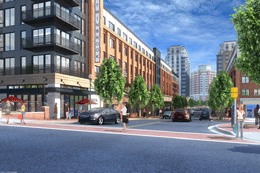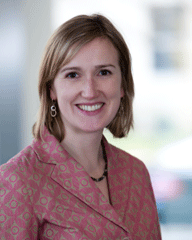Better, Greener Real Estate
Air Date: Week of July 10, 2009

A drawing of the Twinbrook Station redevelopment project.
The principles of smart growth and green building have come together in the first national standard for green neighborhood design. Sophie Lambert of the U.S. Green Building Council tells host Steve Curwood that the LEED for neighborhood development rating system has the potential to change how developers and local governments can work together to create healthy and environmentally-sound neighborhoods.
Transcript
CURWOOD: Well, as homeowner David Gottfried observed, location also plays a role in the environmental footprint of housing. So the Leadership in Energy and Environmental Design program from the U.S. Green Building Council now also has a program for whole neighborhoods.
In 2007, some 240 development projects across the country joined a pilot program, and since then 29 of those projects have gotten LEED certification. Sophie Lambert is Director of LEED for Neighborhood Development and she joins me now.
Welcome to Living on Earth!
LAMBERT: Thank you Steve, hi.
CURWOOD: What are the goals of designing neighborhoods with green building principles?
LAMBERT: Well in terms of LEED for Neighborhood Development we’re really looking at three different things at the same time. We’re looking at the location of the project, we’re looking at the form of the project – so is it walkable, is it compact, is it connected to the neighborhoods around it, and then finally, looking at the performance of the buildings and then beyond the actually building parcels looking at the streets and the sidewalks and the storm water runoff, etc.
CURWOOD: So what are the basic principles behind this work?
LAMBERT: So the basic principles are smart growth and so we’re really looking at how a project’s location could potentially reduce vehicle miles traveled, while at the same time directing growth into existing areas. We have the potential to save prime farmland, to save natural habitat.

Sophie Lambert is the director of the U.S. Green Building Council LEED for Neighborhood Development program.
CURWOOD: So it would seem that old real estate mantra location, location, location means a lot in your rating system.
LAMBERT: Definitely there is emphasis on location, but we really think that the rating system has the potential to transform the market because it looks at location design and green building performance. So maybe the new mantra is location, design and green building.
CURWOOD: Tell me about some successful projects that have gotten LEED certification for neighborhood development now.
LAMBERT: Well, two that are a certified in different parts of the country that I think have some interesting takeaways – and both actually are public-private partnerships, so a local government played a role as a co-developer in both of these projects. One is called Twinburg Station and it’s actually here in the Washington D.C. area. It’s the redevelopment of a former commuter parking lot for the Washington metro transit system here. And it’s a 26-acre project, it’s gonna have offices, it’s gonna have 1600 units of residential and also quite a lot of retail and 80 percent of the buildings will be green buildings.
The second project I wanted to describe briefly was the Gulch. It’s actually in Nashville, Tennesee, so our first certified project in the southeast part of the country. It was a historic rail yard that was abandoned in the 1990s and it’s adjacent to downtown Nashville. And it’s 60 acres, so they’re really looking at the redevelopment of a large number of historic buildings into residences, offices, retail.
And then also looking forward to the future, I mean, this is a multi-phase project so there’ll be quite a large number of buildings, especially residential buildings that are still going to be built in the coming years, but they will be building them to the standards that they’re following in LEED for Neighborhood Development.
CURWOOD: In what ways may zoning laws conflict with the goals of LEED certification? Can you give me some examples?
LAMBERT: Well many of the types of projects that we’re certifying with LEED for Neighborhood Development might be considered illegal with many zoning codes. So what I mean by that is that some of the zoning codes within the country, actually most zoning codes within the U.S. were created in the 50s or 60s and really focus on the use of buildings, and have very, very high numbers of parking spaces that are required for those projects.
So with more and more development being in urban areas and more and more people thinking about taking transit or walking or biking, people aren’t needing to drive quite as much and so, you know, projects aren’t needing quite as much parking. Maybe they can put the parking behind the building instead of in front of it like much of suburban development is built?
So we’re really looking at hopefully encouraging local governments to re-evaluate their zoning codes and makes them more flexible and to make them more about how the buildings sits up against the street and that relationship between the building and the public realm – that space which is sidewalk, the road, the bike lanes, and that building to building space.
CURWOOD: So, tell me, how do economics and race fit into the redevelopment of neighborhoods and greening them?
LAMBERT: We really think that everybody deserves the right to live in a green neighborhood. And so we actually have quite a few credits that look at social equity issues. We have a credit that encourages affordable rental and for sale housing and not just, you know, isolated in one part of a project. We actually through the rating system are trying to encourage affordable housing to be spread throughout a project and to have a variety of different housing sizes and types available for affordable housing.

A drawing of the Twinbrook Station redevelopment project.
LAMBERT: Well we really see the benefits in terms of trying to influence developers from the very beginning of their process. So if we can try to encourage developers to pick sites that would be eligible for LEED N.D. and really direct growth into existing areas, I think we’d be having a very powerful impact.
And then obviously we’re wanting them to make the choices and the commitment to have green building and green infrastructure from that very early on point. So we’re really hoping that local governments will say, you know, wow, we can really see what the environmental and health benefits will be if this LEED for Neighborhood Development eligible project, if we actually approve it.
CURWOOD: Sophie Lambert, thank you so much.
LAMBERT: Thank you, Steve.
CURWOOD: Sophie Lambert is the director of LEED for Neighborhood Development. She comes to us courtesy of our partnership with the U.S. EPA Smart Growth Program and the National Building Museum. And to learn more about the smart growth speaker series, go to our website loe.org.
[MUSIC: Sonny Rollins Quartet “The House I Live In” from “Scoops” (Le Chant du Monde 2002)]
YOUNG: Just ahead: there’s a new push to cut cold war arsenals – but that does not mean the threat of nuclear weapons is receding. Stay with us on Living on Earth.
Links
LEED for Neighborhood Development
The Gulch, Nashville is the first LEED-certified neighborhood in the South.
Living on Earth wants to hear from you!
Living on Earth
62 Calef Highway, Suite 212
Lee, NH 03861
Telephone: 617-287-4121
E-mail: comments@loe.org
Newsletter [Click here]
Donate to Living on Earth!
Living on Earth is an independent media program and relies entirely on contributions from listeners and institutions supporting public service. Please donate now to preserve an independent environmental voice.
NewsletterLiving on Earth offers a weekly delivery of the show's rundown to your mailbox. Sign up for our newsletter today!
 Sailors For The Sea: Be the change you want to sea.
Sailors For The Sea: Be the change you want to sea.
 The Grantham Foundation for the Protection of the Environment: Committed to protecting and improving the health of the global environment.
The Grantham Foundation for the Protection of the Environment: Committed to protecting and improving the health of the global environment.
 Contribute to Living on Earth and receive, as our gift to you, an archival print of one of Mark Seth Lender's extraordinary wildlife photographs. Follow the link to see Mark's current collection of photographs.
Contribute to Living on Earth and receive, as our gift to you, an archival print of one of Mark Seth Lender's extraordinary wildlife photographs. Follow the link to see Mark's current collection of photographs.
 Buy a signed copy of Mark Seth Lender's book Smeagull the Seagull & support Living on Earth
Buy a signed copy of Mark Seth Lender's book Smeagull the Seagull & support Living on Earth

